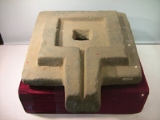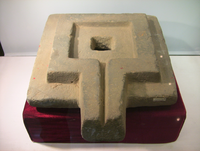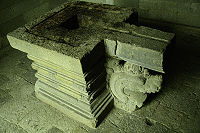
Yoni
Encyclopedia

Sanskrit
Sanskrit , is a historical Indo-Aryan language and the primary liturgical language of Hinduism, Jainism and Buddhism.Buddhism: besides Pali, see Buddhist Hybrid Sanskrit Today, it is listed as one of the 22 scheduled languages of India and is an official language of the state of Uttarakhand...
word for the vagina
Vagina
The vagina is a fibromuscular tubular tract leading from the uterus to the exterior of the body in female placental mammals and marsupials, or to the cloaca in female birds, monotremes, and some reptiles. Female insects and other invertebrates also have a vagina, which is the terminal part of the...
. Its counterpart is the lingam
Lingam
The Lingam is a representation of the Hindu deity Shiva used for worship in temples....
as interpreted by some, the phallus
Phallus
A phallus is an erect penis, a penis-shaped object such as a dildo, or a mimetic image of an erect penis. Any object that symbolically resembles a penis may also be referred to as a phallus; however, such objects are more often referred to as being phallic...
.
It is also the divine passage, womb or sacred temple (cf. lila). The word covers a range of meanings, including: place of birth, source, origin, spring, fountain, place of rest, repository, receptacle, seat, abode, home, lair, nest, stable.
In Indian religions
In Hinduism, the ancient IndianVedic period
The Vedic period was a period in history during which the Vedas, the oldest scriptures of Hinduism, were composed. The time span of the period is uncertain. Philological and linguistic evidence indicates that the Rigveda, the oldest of the Vedas, was composed roughly between 1700–1100 BCE, also...
texts contain the word yoni in various contexts. In Hindu philosophy
Hindu philosophy
Hindu philosophy is divided into six schools of thought, or , which accept the Vedas as supreme revealed scriptures. Three other schools do not accept the Vedas as authoritative...
, according to Tantra
Tantra
Tantra , anglicised tantricism or tantrism or tantram, is the name scholars give to an inter-religious spiritual movement that arose in medieval India, expressed in scriptures ....
, yoni is the origin of life. The yoni is also considered to be an abstract representation of Shakti
Shakti
Shakti from Sanskrit shak - "to be able," meaning sacred force or empowerment, is the primordial cosmic energy and represents the dynamic forces that are thought to move through the entire universe in Hinduism. Shakti is the concept, or personification, of divine feminine creative power, sometimes...
and Devi
Devi
Devī is the Sanskrit word for Goddess, used mostly in Hinduism, its related masculine term is deva. Devi is synonymous with Shakti, the female aspect of the divine, as conceptualized by the Shakta tradition of Hinduism. She is the female counterpart without whom the male aspect, which represents...
, the creative force that moves through the entire universe.
In Indian religions according to Vedas
Vedas
The Vedas are a large body of texts originating in ancient India. Composed in Vedic Sanskrit, the texts constitute the oldest layer of Sanskrit literature and the oldest scriptures of Hinduism....
and Bhagavad Gita
Bhagavad Gita
The ' , also more simply known as Gita, is a 700-verse Hindu scripture that is part of the ancient Sanskrit epic, the Mahabharata, but is frequently treated as a freestanding text, and in particular, as an Upanishad in its own right, one of the several books that constitute general Vedic tradition...
, Yoni is a form of life or a species
Species
In biology, a species is one of the basic units of biological classification and a taxonomic rank. A species is often defined as a group of organisms capable of interbreeding and producing fertile offspring. While in many cases this definition is adequate, more precise or differing measures are...
. There are 84 lakh
Lakh
A lakh is a unit in the Indian numbering system equal to one hundred thousand . It is widely used both in official and other contexts in Pakistan, Bangladesh, India, Maldives, Nepal, Sri Lanka, Myanmar and is often used in Indian English.-Usage:...
(84,00,000) yonis total with Manushya Yoni ( Human form/human species) as one of them. A human (manushya yoni) is obtained on the basis of good karma
Karma
Karma in Indian religions is the concept of "action" or "deed", understood as that which causes the entire cycle of cause and effect originating in ancient India and treated in Hindu, Jain, Buddhist and Sikh philosophies....
(deeds) before which a human goes through various forms of yonis (for example, insect, fish, deer, monkey, etc.). Bad karmas will lead one to be born in rakshasha yoni (evil form). The births and rebirths (the cycle of life) of a human happens in various yonis. A human who achieves the enlightenment
Enlightenment (spiritual)
Enlightenment in a secular context often means the "full comprehension of a situation", but in spiritual terms the word alludes to a spiritual revelation or deep insight into the meaning and purpose of all things, communication with or understanding of the mind of God, profound spiritual...
(Mokshya) breaks the cycle of reincarnation
Reincarnation
Reincarnation best describes the concept where the soul or spirit, after the death of the body, is believed to return to live in a new human body, or, in some traditions, either as a human being, animal or plant...
and adjoins Brahma
Brahma
Brahma is the Hindu god of creation and one of the Trimurti, the others being Vishnu and Shiva. According to the Brahma Purana, he is the father of Mānu, and from Mānu all human beings are descended. In the Ramayana and the...
.
Linga-yoni
The yoni is the creative power of nature and represents the goddess ShaktiShakti
Shakti from Sanskrit shak - "to be able," meaning sacred force or empowerment, is the primordial cosmic energy and represents the dynamic forces that are thought to move through the entire universe in Hinduism. Shakti is the concept, or personification, of divine feminine creative power, sometimes...
. The linga stone represents Shiva
Shiva
Shiva is a major Hindu deity, and is the destroyer god or transformer among the Trimurti, the Hindu Trinity of the primary aspects of the divine. God Shiva is a yogi who has notice of everything that happens in the world and is the main aspect of life. Yet one with great power lives a life of a...
, and is usually placed in the yoni. The lingam is the transcendental source of all that exists. The linga united with the yoni represents the nonduality of immanent reality and transcendental potentiality
Potentiality and actuality
In philosophy, Potentiality and Actuality are principles of a dichotomy which Aristotle used throughout his philosophical works to analyze motion, causality, ethics, and physiology in his Physics, Metaphysics, Ethics and De Anima .The concept of potentiality, in this context, generally refers to...
.
Worship
In ShaktismShaktism
Shaktism is a denomination of Hinduism that focuses worship upon Shakti or Devi – the Hindu Divine Mother – as the absolute, ultimate Godhead...
the yoni is celebrated and worshipped during the Ambubachi Mela
Ambubachi Mela
The Ambubachi Mela is the most important mela celebrated in the Kamakhya Temple in Guwahati, Assam. This yearly mela is celebrated during the monsoon season that happens to fall during the assamese month Ahaar, around the middle of June, when the Brahmaputra river is in spate. It is the celebration...
, an annual fertility festival held in June, in Assam
Assam
Assam , also, rarely, Assam Valley and formerly the Assam Province , is a northeastern state of India and is one of the most culturally and geographically distinct regions of the country...
, India, which celebrates the Earth's menstruation
Menstruation
Menstruation is the shedding of the uterine lining . It occurs on a regular basis in sexually reproductive-age females of certain mammal species. This article focuses on human menstruation.-Overview:...
. During Ambubachi, the annual menstruation course of the goddess Kamakhya
Kamakhya
Kamakhya is an important Tantric mother goddess closely identified with Kali and Maha Tripura Sundari, according to the Tantric texts that are the basis for her worship at the Kamakhya temple, a 16th century temple in the Kamrup district of Assam...
is worshipped in the Kamakhya Temple
Kamakhya Temple
The Kamakhya Temple is a Shakti Peeth temple situated on the Nilachal Hill in western part of Guwahati city in Assam, India. It is the main temple in a complex of individual temples dedicated to different forms of the mother goddess as the Dasa Mahavidya, including Bhuvaneshvari, Bagalamukhi,...
. The temple stays closed for three days and then reopens to receive pilgrims and worshippers. It is one of the most important pilgrimage sites in the world, attracting millions of visitors each year, particularly for Ambubachi Mela which draws upwards of 100,000 pilgrims per day during the 4-day festival.
Darshan
Darshan
or Darshan is a Sanskrit term meaning "sight" , vision, apparition, or glimpse. It is most commonly used for "visions of the divine" in Hindu worship, e.g. of a deity , or a very holy person or artifact...
at this temple is performed not by sight as in most temples, but by touch. There is a large cleft, a yoni in the bedrock moistened by water flowing upward from an underground spring, generally covered by cloths and ornate chunris
Dupatta
Dupatta Dupatta(Urdu: دوپٹا, Hindi: दुपट्टा, Bengali: ওড়না, Sindhi: پوتي, Tamil:துப்பட்ட) Dupatta(Urdu: دوپٹا, Hindi: दुपट्टा, Bengali: ওড়না, Sindhi: پوتي, Tamil:துப்பட்ட) (alternative names include chadar (in Pakistan), orni/odhni, chunri, chunni, orna, and pacheri, is a long,...
, flowers, and red sindoor
Sindoor
Sindoor is a traditional red or orange-red colored cosmetic powder from the Indian subcontinent, usually worn by married women along the parting of their hair. Usage of sindoor denotes that a woman is married in many Hindu communities, and ceasing to wear it usually implies widowhood...
powder. Devotees and pilgrims offer items for worship directly to the goddess, then touch her and drink water from the spring. They then receive a tilak and prasad
Prasad
Prasād is a mental condition of generosity, as well as a material substance that is first offered to a deity and then consumed...
by the attending priest. After completing darshan, devotees light lamps and incense outside the temple. Like other temples, worship is not considered complete until the temple is circumambulated clockwise.

In archeology
Lingam-yonis have been recovered from the archeological sites at HarappaHarappa
Harappa is an archaeological site in Punjab, northeast Pakistan, about west of Sahiwal. The site takes its name from a modern village located near the former course of the Ravi River. The current village of Harappa is from the ancient site. Although modern Harappa has a train station left from...
and Mohenjo-daro
Mohenjo-daro
Mohenjo-daro is an archeological site situated in what is now the province of Sindh, Pakistan. Built around 2600 BC, it was one of the largest settlements of the ancient Indus Valley Civilization, and one of the world's earliest major urban settlements, existing at the same time as the...
, part of the Indus Valley Civilization
Indus Valley Civilization
The Indus Valley Civilization was a Bronze Age civilization that was located in the northwestern region of the Indian subcontinent, consisting of what is now mainly modern-day Pakistan and northwest India...
. There is strong evidence to support cultural continuation from the Indus Valley Civilization (Harappan; Indus-Sarasvati) to Vedic and modern Hindu practices.
Other uses
- Yoni MudraMudraA mudrā is a symbolic or ritual gesture in Hinduism and Buddhism. While some mudrās involve the entire body, most are performed with the hands and fingers...
is a principle in meditation used to reduce distraction during the beginning of yoga practice. - In the Thai language the sharp corner of the eye closest to the nose is referred to as "Yoni Tha" where "Tha" means the eye.
- Yoni is the vulvaVulvaThe vulva consists of the external genital organs of the female mammal. This article deals with the vulva of the human being, although the structures are similar for other mammals....
in texts such as the Kama SutraKama SutraThe Kama Sutra is an ancient Indian Hindu text widely considered to be the standard work on human sexual behavior in Sanskrit literature written by Vātsyāyana. A portion of the work consists of practical advice on sexual intercourse. It is largely in prose, with many inserted anustubh poetry verses...
. - A child is born from a yoni of stars - constellations that prevailed during the child birth. The AryanAryanAryan is an English language loanword derived from Sanskrit ārya and denoting variously*In scholarly usage:**Indo-Iranian languages *in dated usage:**the Indo-European languages more generally and their speakers...
s had identified some 50,000 astrological yonis that favour a child's birth. - The Aryans used the term yoni in agriculture. A 'fertile yoni' meant a good harvestHarvestHarvest is the process of gathering mature crops from the fields. Reaping is the cutting of grain or pulse for harvest, typically using a scythe, sickle, or reaper...
of crops.

